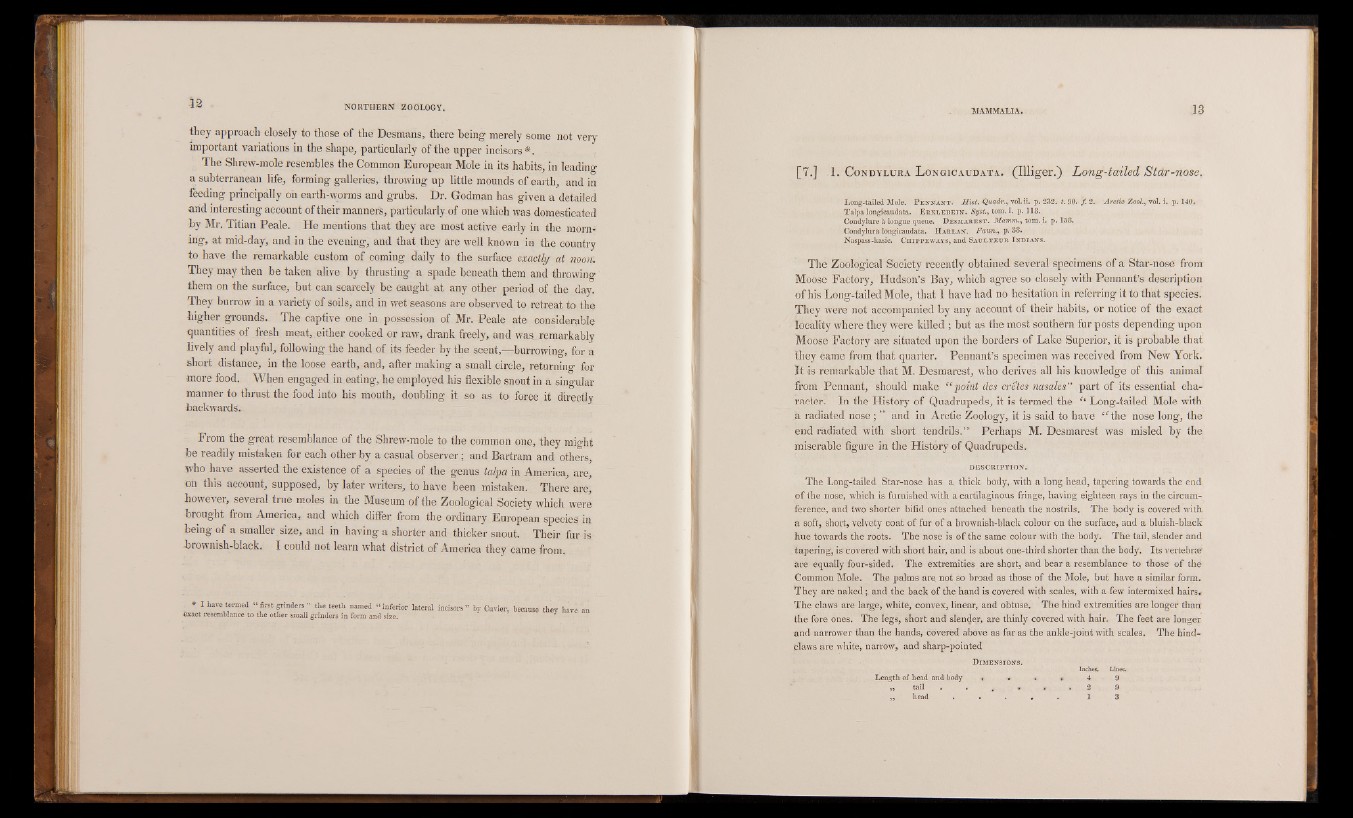
they approach closely to those of the Desmans, there being merely some not very-
important variations in the shape, particularly of the upper incisors *.
The Shrew-mole resembles the Common European Mole in its habits, in leading
a subterranean life, forming galleries, throwing up little mounds of earth, and in
feeding principally oh earth-worms and grubs. Dr. Godman has given a detailed
and interesting account of their manners, particularly of one which was domesticated
by Mr. Titian Peale. He mentions that they are most active early in the morning,
at mid-day, and in the evening, and that they are well known in the country
to have the remarkable custom of coming daily to the surface exactly at nooit.
They may then be taken alive by thrusting a spade beneath them and throwing
them on the surface, but can scarcely be caught at any other period of the day.
They burrow in a variety of soils, and in wet seasons are observed to retreat to the
higher grounds. The captive one in possession of Mr. Peale ate considerable
quantities of fresh meat, either cooked or raw, drank freely, and was remarkably
lively and playful, following the hand of its feeder by the scent,—burrowing, for a
short distance, in the loose earth, and, after making a small circle, returning for
more food. When engaged in eating, he employed his flexible snout in a singular
manner to thrust the food into his mouth, doubling it so as to force it directly
backwards.
From the great resemblance of the Shrew-mole to the common one, they might
be readily mistaken for each other by a casual observer; and Bartram and others,
who have asserted the existence of a species of the genus tulpa in America, are,
on this account, supposed, by later writers, to have been mistaken. There are,
however, several true moles in the Museum of the Zoological Society which were
brought from America, and which differ from the ordinary European species in
being of a smaller size, and in having a shorter and thicker snout. Their fur is
brownish-black. I could not learn what district of America they came from.
* I have termed “ first grinders ” the teeth named “ inferior lateral incisors ” by Cuvier,
teact resemblance to the other small grinders in form and size. because they have an
[7.] 1. C o n d y l u r a L o n g ic a u d a t a . (Illiger.) Long-tailed, Stdr-nose.
Long-tailed Mole. P ennant. Hist. Quadr., vol. ii. p. 232. t. 90. f 2. Arctic Zool., vol. i. p. 140.
Talpa longicaudata. E rxlebein. Syst., tom. i. p. 118.,
Condylure a longue queue. Desmarest. Mamm., tom. i. p. 158.
Condylura longicaudata. Harlan. Faun., p. 38.
Naspass-kasic. Chippeways, and Saulteur I ndians.
The Zoological Society recently obtained several specimens of a Star-nose from
Moose Factory, Hudson’s Bay, which agree so closely with Pennant’s description
of his Long-tailed Mole, that I have had no hesitation in referring it to that species.
They were not accompanied by any account of their habits, or notice of the exact
locality where they were killed ; but as the most southern fur posts depending upon
Moose Factory are situated upon the borders of Lake Superior, it is probable that
they came from that quarter. Pennant’s specimen was received from New York.
It is remarkable that M. Desmarest, who derives all his knowledge of this animal
From Pennant, should make “point des cretes ?iasales” part of its essential character.
In the History of Quadrupeds, it is termed the “ Long-tailed Mole with
a radiated nose; ” and in Arctic Zoology, it is said to have <fthe nose long, the
end radiated with short tendrils.” Perhaps M. Desmarest was misled by the
miserable figure in the History of Quadrupeds.
DESCRIPTION.,
The Long-tailed Star-nose has a thick body, with a long head, tapering towards the end
of the nose, which is furnished with a cartilaginous fringe, having eighteen rays in the circumference,
and two shorter bifid ones attached beneath the nostrils. The body is covered with,
a soft, short, velvety coat of fur of a brownish-black colour on the surface, and a bluish-black
hue towards the roots. The nose is of the same colour with the body. The tail, slender and
tapering, is covered with short hair, and is about one-third shorter than the body. Its vertebrsef
are equally four-sided. The extremities are short, and bear a resemblance to those of thé
Common Mole. The palms are. not so broad as those of the Mole, but have a similar form.
They are naked; and the back of the hand is covered with scales, with a few intermixed hairs*
The claws are large, white, convex, linear, and obtuse. The hind extremities are longer than;
the fore ones. The legs, short and slender, are thinly covered with hair. The feet are longer
and narrower than the hands, covered above as far as the ankle-joint with scales. The hind-
claws are white, narrow, and sharp-pointed
Length of head and body t ■*
Inches.
* 4 9
,, tail . . i i * » 2 9
■ „ head . . . . 1 3